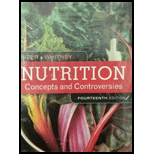
Bundle: Nutrition: Concepts and Controversies, Loose-leaf Version, 14th + LMS Integrated for MindTap Nutrition, 1 term (6 months) Printed Access Card
14th Edition
ISBN: 9781337127547
Author: Frances Sizer, Ellie Whitney
Publisher: Cengage Learning
expand_more
expand_more
format_list_bulleted
Question
Chapter 11, Problem 12SC
Summary Introduction
Introduction:
The blood pressure is a pressure of the blood that exerted on the arterial wall at the time of heart pumps blood in the aorta. Normal blood pressure is 120/ 80 mmHg. Reading over normal blood pressure reaches up to 139/89 mmHg is considered as high blood pressure. If high blood pressure persists over a long period of time it is called hypertension.
Expert Solution & Answer
Want to see the full answer?
Check out a sample textbook solution
Chapter 11 Solutions
Bundle: Nutrition: Concepts and Controversies, Loose-leaf Version, 14th + LMS Integrated for MindTap Nutrition, 1 term (6 months) Printed Access Card
Ch. 11 - Complementary and alternative medicines (CAM)...Ch. 11 - Prob. 2RQCh. 11 - Prob. 3RQCh. 11 - Prob. 1CTCh. 11 - Prob. 2CTCh. 11 - Prob. 1SCCh. 11 - Prob. 2SCCh. 11 - A healthy digestive system defends against...Ch. 11 - Prob. 4SCCh. 11 - Prob. 5SC
Ch. 11 - Prob. 6SCCh. 11 - Prob. 7SCCh. 11 - Prob. 8SCCh. 11 - Men suffer more often from heart attacks than...Ch. 11 - Smoking powerfully raises the risk for CVD in men...Ch. 11 - Which of the following minerals may help to...Ch. 11 - Prob. 12SCCh. 11 - Prob. 13SCCh. 11 - Prob. 14SCCh. 11 - Prob. 15SCCh. 11 - Prob. 16SCCh. 11 - Prob. 17SCCh. 11 - Prob. 18SCCh. 11 - Prob. 19SCCh. 11 - Prob. 20SC
Knowledge Booster
Recommended textbooks for you
 Comprehensive Medical Assisting: Administrative a...NursingISBN:9781305964792Author:Wilburta Q. Lindh, Carol D. Tamparo, Barbara M. Dahl, Julie Morris, Cindy CorreaPublisher:Cengage LearningEssentials Health Info Management Principles/Prac...Health & NutritionISBN:9780357191651Author:BowiePublisher:Cengage
Comprehensive Medical Assisting: Administrative a...NursingISBN:9781305964792Author:Wilburta Q. Lindh, Carol D. Tamparo, Barbara M. Dahl, Julie Morris, Cindy CorreaPublisher:Cengage LearningEssentials Health Info Management Principles/Prac...Health & NutritionISBN:9780357191651Author:BowiePublisher:Cengage Nutrition: Concepts and Controversies - Standalo...Health & NutritionISBN:9781305627994Author:Frances Sizer, Ellie WhitneyPublisher:Brooks Cole
Nutrition: Concepts and Controversies - Standalo...Health & NutritionISBN:9781305627994Author:Frances Sizer, Ellie WhitneyPublisher:Brooks Cole- Essentials of Pharmacology for Health ProfessionsNursingISBN:9781305441620Author:WOODROWPublisher:Cengage

Comprehensive Medical Assisting: Administrative a...
Nursing
ISBN:9781305964792
Author:Wilburta Q. Lindh, Carol D. Tamparo, Barbara M. Dahl, Julie Morris, Cindy Correa
Publisher:Cengage Learning

Essentials Health Info Management Principles/Prac...
Health & Nutrition
ISBN:9780357191651
Author:Bowie
Publisher:Cengage

Nutrition: Concepts and Controversies - Standalo...
Health & Nutrition
ISBN:9781305627994
Author:Frances Sizer, Ellie Whitney
Publisher:Brooks Cole



Essentials of Pharmacology for Health Professions
Nursing
ISBN:9781305441620
Author:WOODROW
Publisher:Cengage